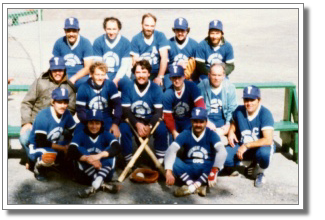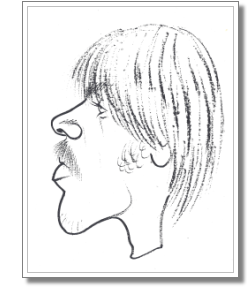Tigers History
The CN Recreation Association was a sports and recreation association for the employees of the Canadian National Railway. History goes way back and it is believed that the association was started in the 1930's.
In the 1970's, the C.N.R.A. opened a few softball parks in the rail yards in and around the Montreal area. Jack Cann Ballpark was located in the rail yards on the Montreal side of the Victoria Bridge. It was used for C.N.R.A league play for many years in the 1970's and 1980's.
The Lachine ballpark was located in Lachine. It was considered the "minors" compared to the centrally located Jack Cann Park.
In 1981, the C.N.R.A opened a third park on Montreal's South Shore. It was for players of the newly formed South Shore C.N.R.A softball league. The South Shore Park was located in the train yards in St-Lambert. The park was in an area known to local residents as the swamp because it was really a swamp until CN plowed it over and filled it in around 1975.
The new softball league consisted of teams formed of departments from CN in and around the Montreal area. The Bears were formed from employees of CN's head office signal design department. The Victorieux were formed from employees who worked exclusively on CN's Victoria Bridge. The A's were formed from employees of head office's fifth floor computer room. The Tigers were formed from members of head office's Management Services and check control personnel.

The new St-Lambert ballpark was not ready for primetime: it had just a backstop with no lights, no fences and no turf. Fans were forced to sit in a single bleacher unit that had already seen its day. The newly formed league played their first games on the evening of May 18, 1981. Teams that year included the Lions, Tigers, Expos, No Stars, Pirates, Shifters, Bullets and The Saints.
Players in the inaugural season of the Tigers included Phil Anderson, Frank Franchellini, Ian Gillespie, Tommy Hansen, Rick Jubinville, Warren Kidd, Bob Lecompte, Al Macintyre, Eddy Marchand, Julius Marchand, Wesley Roberts, Danny Ryland, Frank Sivilla, Ken Swinwood and Bill Zinn.
That 1981 season was the first year of the park and it was the Management Services Tigers who won their one and only league championship. The Tigers had a tremendous team and a huge following of fans. It was after that inaugural 1981 championship season when the St-Lambert ballpark was rebranded Tiger Stadium.
In preparation for the 1982 season, CN installed a new backstop, fences, lighting and real turf at Tiger Stadium. They also constructed changing rooms and installed new bleachers for the fans. Tiger Stadium was now a great looking ballpark.
The 1982 season saw some teams drop out and some other teams were formed. One new team included The Victorieux, a team compiled of CN employees who worked on the Victoria Bridge. This team was a bunch of young and buff guys who would eventually become heated rivals of The Tigers. Victorieux beat the Tigers in the 1982 playoffs to take the second season.
The Outlaws and A's join the league
Other teams came and went throughout the years including Jos Boisvert's A's, The Smurfs, Voyageurs, Aventuriers, Bears and Ted Golding's Outlaws. The Outlaws were another team of young and buff guys who had previously been playing under the name of the Brewers in what many considered the “minor leagues” in the Lachine CNRA league.
Team founding members included Ted Golding, Pierre Valois, Rod D'Amato and Frank Franchillini who all worked in CN Rail's head office 4th floor computer room. Many of the Outlaws originally wanted to play for either the A’s or Tigers but there just was no room for them, so they formed their own team. The rivalry between these 3 teams was instantaneous. There was no hate but there was no love either. Many considered the Outlaws a very cocky bunch but so were the Victorieux a year earlier.
The Outlaws quickly came together and started to attract really excellent quality guys and better ballplayers. They brought in the likes of Brian Laurie, Doug Levia, Scott Morningstar, Paul Brazier, Sid Leahy, Sylvain Leclerc and Keith Webster to name a few. The team became an instant success and ended up winning two championships but more importantly were part of a league that everyone could be proud to play in.
CN sells Tiger Stadium to condo developers
After the 1987 playoffs, CN sold Tiger Stadium to condo developers. Players and fans were devastated because it was the end of an era and the end of a great ballpark. During the history of Tiger Stadium, some teams came and went after just one season while others lasted longer but the only team to play all 7 seasons of the existence of Tiger Stadium were The Tigers.

To replace Tiger Stadium, CN constructed another ballpark for the South Shore C.N.R.A. in the yards on the other side of the tracks in St-Lambert. It was bigger and better but was just not the same. Tiger Stadium was legendary, it was located in a secluded area just off the St-Lambert train yards. Noise was not an issue, there was plenty of parking and fans could drink all they wanted to. The new ballpark was just across the tracks from the old ballpark but located in a largely residential area. Many still recall the week-end when many ball players went to lay the turf for the new ballpark.
The new ballpark would affectionately be known as Chester Field, named after Chester Zboch, Manager of the computer department at CN Rail's head office in Montreal. It was a beautiful park constructed exclusively to replace Tiger Stadium but the South Shore C.N.R.A. Softball League would play there for just six years.
With cost cutting measures of Canadian railroads in the 1990's, CN closed Chester Field after the 1993 season and sold the ballpark to the City of St-Lambert for $1.00. Chester Field would be renamed Parc St-Charles and it was the end of an era for CN, The CNRA, The Tigers and The Outlaws.











